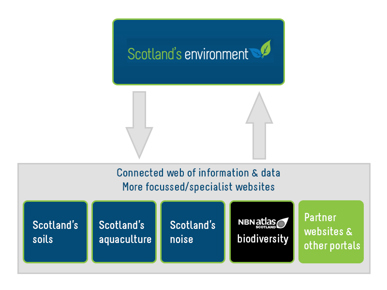Scotland's environment web aims to be the trusted gateway to everything you want to know about Scotland's environment; bringing together environmental information and data so that it is easy to search, discover, view, analyse and interpret.
We want to help extend the reach and influence of the data and information published by our partners and help users get to the data they need, when they need it. One of the ways we're doing this is through the 'part of' family of websites. Here we explain more about what this means.
Scotland's environment web
December 04, 2017
Helping users get to trusted and authoritative data
Back in the early days of the Scotland’s environment web project (EU LIFE+ project), the team received feedback from a wide range of users to help shape our vision of what we wanted to achieve – through surveys, workshops and research with Abertay University. From this work we concluded that:
- users wanted to access unbiased and factual data to help answer questions they had about the environment;
- when searching for information and data, users consistently went to their default search engine of choice e.g. Google;
- users found it difficult to identify trusted and authoritative information in their returned search results;
- users found it challenging to determine how relevant and up-to-date the information they did find was.
As a result of the partners involved in Scotland’s environment web, and the fact that data applications on the website harvest the most up-to-date data (which is published and managed at source, and from multiple sources), we had a clear and 'unique selling point' of being the portal to trusted and authoritative data. We wanted to build on this by signposting users to further sources of trusted and authoritative data and information. And this is where the idea of 'part of Scotland's environment' developed from.
So what is 'part of Scotland’s environment'?
In addition to the centralised Scotland's environment web portal, there is a growing network of trusted and authoritative sources of more detailed and specilaised environmental data. This network has developed through partnerships and collaborations, and consists of websites aimed at users with an interest in more specific topic based data sets and who want to carry out more detailed data analysis. These websites often publish data on specific environmental topics rather than the broad overview of multiple topics offered through the Scotland's environment website. Similar data viewing and analysis tools are available but will have a more focused data scope and often more advanced functionality.

You can easily recognise other websites that are part of Scotland's environment by the logo:

Websites that are currently part of the network include:
Scotland's soils: data and information on Scotland's soils. A collaboration with the Scottish Environment Protection Agency (SEPA), The James Hutton Institute, Forestry Commission Scotland, Scottish Government and NatureScot.
Scotland's aquaculture: data about the aquaculture industry in Scotland. A collaboration with the Scottish Environment Protection Agency (SEPA), Marine Scotland, Food Standards Scotland and Crown Estate Scotland.
Scotland's noise: view maps of noise from road, rail, air traffic and industry. Scottish Government.
NBN Atlas Scotland: data on plants, animals and habitats in Scotland. National Biodiversity Network.
And we hope to grow this network further over time.
Over the course of the next few weeks, we will provide a more in-depth feature of some of these websites in our blog - watch this space to find out more.
Adobe Acrobat Reader is the free, trusted leader for reliably viewing, annotating and signing PDFs.
Download Adobe Acrobat Reader


